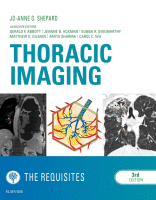Physical Address
304 North Cardinal St.
Dorchester Center, MA 02124

Introduction The most common interventional procedures in thoracic radiology are drainage of air or fluid collections followed by percutaneous transthoracic needle biopsy (PTNB) of lung and mediastinal lesions. Other procedures are placement of localization markers in lung parenchyma to facilitate…

Introduction A standardized staging system is fundamental in delivering evidence-based treatment tailored to an individual patient. To determine the extent of a tumor and choose treatment strategies, an accurate staging system is essential. The stage of the tumor is the…

Lung cancer is suitable for screening because of identifiable risk factors that allow targeted screening of high-risk individuals, its significant prevalence, the existence of a preclinical phase, its high morbidity and mortality, and evidence that treatment in early-stage disease is…

Introduction A pulmonary nodule is defined as a rounded or irregular opacity measuring up to 3 cm in diameter. There are many etiologies, both benign and malignant, of lung nodules ( Table 22.1 ). Some opacities can resemble a nodule but…

Lung cancer is the leading cause of cancer mortality in the United States, accounting for more than 150,000 deaths each year. In addition to lung cancer, the chapter reviews primary malignant and benign pulmonary tumors more commonly encountered in clinical…

Introduction Obstructive lung diseases consist of a heterogeneous group of chronic respiratory illnesses characterized by airway obstruction and air trapping ( Box 20.1 ). The most common causes include chronic obstructive pulmonary disease (COPD), which includes emphysema and chronic bronchitis,…

Introduction Industrial and technological advancements have made occupational lung diseases a major cause of work-related illness. The pneumoconioses are a set of lung diseases caused by the repeated inhalation and retention of small particles within the lung. The resultant lung…

Introduction There are innumerable causes of chronic diffuse lung disease. This chapter reviews the common causes of diffuse lung disease, including the idiopathic interstitial pneumonias (IIPs), connective tissue disease (CTD), hypersensitivity pneumonitis (HP), sarcoidosis, cystic lung disease, eosinophilic lung disease,…

Introduction Diffuse lung diseases are often detected and initially evaluated on chest radiographs (CXR). A CXR can provide valuable clues regarding pulmonary pathology such as the lung volume, distribution, and characterization of abnormalities. Radiographs assess lung volumes and distribution of…

Introduction The genus Mycobacterium contains numerous acid-fast staining aerobic bacilli that result in a variety of infections in human hosts. Pulmonary infections by Mycobacterium spp. are characterized as tuberculous (TB) mycobacterial infection and nontuberculous mycobacterial (NTM) infection . Tuberculous Mycobacterial…